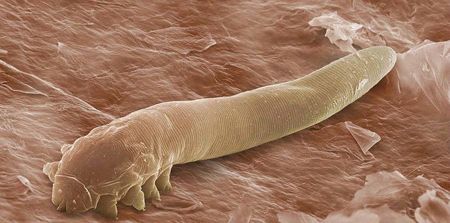by Larry
February, 2017Our Many Mini-MitesEww, gross! Lots of folks have heard of or experienced problems of lice, ticks, chiggers, fleas, fungal infections, and bedbugs infesting our clothes, bedding, or persons, but mites? Not so much. Yet it turns out that these last parasites are at least as common inhabitants of our bodily biospheres as the more typically considered free-riders on human flesh. In fact, we have mites so characteristic of ourselves and our backgrounds that an analysis of the ones we carry around all the time tells scientists much about from where our forebears came. Happily, the illustration image is not to scale. These alien looking arthropods are microscopic, the largest of them only 0.2 mm, or roughly 0.008 inches, in length, hence the reference to them as mini-mites. Scientists have known for well over a century that mites live on our faces. They were thought to affect only a small percentage of us and to have been responsible for such dermatalogical disorders as rosacea. While initial investigations supported the notion that only a fraction of folks play host to these translucent creatures, once DNA studies had become more the norm researchers began looking for the mites' DNA on human subjects and found that actually just about all of us, 100% of adults in any case, have Demodex mites. To date, they are the first genus of arthropods to be found on the bodies of everyone studied. This begs the question, then, how do we get them? Do we come out of the womb with the mites, or do they arrive later? Newborn infants generally do not have them. Perhaps they arrive from our mothers during breast feeding. What about people who were entirely bottle-fed? Well, by age 18 at least, they have them too. So...scientists are as yet simply not sure how the mites are transmitted. One way or another, though, once we are cadavers, virtually all of us have them!
Two kinds of mites live on humans, Demodex folliculorum and Demodex brevis. The latter species is also a relative of those that can cause the common dog disorder, mange. Fortunately, our version does not affect us in this way. How many mini-mites are swimming around in our skin pore oils at any given time? Probably thousands, maybe millions. Fortunately, most of the time they cause us no discomfort or disorders whatever and do not require treatment. In fact, providers of remedies for normal, asymptomatic human mites may do no good and possibly can be harmful not merely to our pocketbooks but even to our health. Not all mite cures are safe for direct application to people. Itch mites and scabies mites, on the other hand, may be treated, but these problems are caused by kinds of parasites that cannot live on human hosts beyond an initial infestation anyway. Later research has shown that the genetic diversity of parasitic facial mites can tell scientists more about our family trees and the major migrations patterns of our ancestors. Minute genetic variations in the mites allow experts to tell if people are, for example, from China, the Americas, or Africa following the great dispersion routes of our species 60,000-100,000 years ago. Among Americans, human ancestry can be classified into one of four categories, A through D, based on subtle differences between our mites' DNA. All four lines of mites occur on folks of African descent. People with mostly the D-line but not the others are virtually only of European descent. Those with B- and C-lines are mostly Americans of Asian descent. People whose roots were primarily South American have A- and D-lines. Thus it seems our mites have been with us for hundreds of thousands of their generations and that they are in a sense "loyal," sticking with their traditional human family ties. As yet human mites have not been studied extensively. Apparently this is a rich new field for ongoing discovery. Primary Sources: - Facial Mites Reveal Where You Come From. Rasmus Kragh Jacobsen in Scientific Nordic; January 7, 2016. - Hey, You've Got Mites Living On Your Face. And I Do, Too. Nancy Shute in NPR - Your Health; August 28, 2014. |
